Keywords
Hand hygiene; Swab tests; Hand washing; Bioluminesence
Introduction
Studies, conducted upon the evaluation of hand hygiene in the school environment are mainly focusing in the relation of hand hygiene with the transmission of various diseases and the mitigation of contamination. A double-blind, placebo-controlled, study among school students1 reports that hand-washing is the most effective way to prevent spreading of communicable disease. An alcohol-free, instant hand sanitizer (containing surfactants, allantoin and benzalkonium chloride) could reduce illness absenteeism in a population of 769 elementary school children and serve as an effective alternative when regular soap and water hand washing was not readily available. After 5 weeks, students using the active product were 33% less likely to have been absent because of illness when compared with the placebo group [1].
Furthermore, with the recent emergence of severe acute respiratory syndrome (SARS), a newly discovered infectious disease, the importance of primary infection control measures have been highlighted [2]. Routine handwashing with soap and water has been cited by the World Health Organization (WHO) as being "the most important hygiene measure in preventing the spread of infection" [3]. The elementary school environment is also negatively impacted by outbreaks of disease causing microorganisms [4,5]. These occasional outbreaks result in increased student and teacher absenteeism, increased healthcare expenditures, and an overall decline in the children's learning environment [5]. The United States CDC has estimated that the average school-aged child missed approximately one week annually due to illness-related absenteeism in 1995 [6]. Despite the scientifically proven evidence of the effectiveness of handwashing, and the increasing promotion of proper hand hygiene techniques, observational studies in school settings have indicated that handwashing practices are often lacking [7,8]. Guinan et al. reported that proper handwashing compliance, with soap and water, in school-aged children ranged from 8 to 28 percent. Reported reasons for the observed inadequacy in compliance included insufficient time during the day, and the use of substandard washing facilities in hard to access locations of the school environment [9,10].
A study conducted in order to evaluate the outcomes upon oral hygiene versus hand hygiene four weeks after a short education (15 minutes) for preschool children. The results of the study show that even a short, school-based educational intervention at an early age may affect children's health promotion significantly. Teachers should, therefore, be encouraged to educate children from an early age about oral and general hygiene practices [11]. Another study conducted to assess hand-washing behaviours and intentions among school children in Bogotá, Colombia, helped to identify and overcome barriers to proper hygiene practices. The conclusion of this study is that the scarcity of adequate facilities in most schools in Bogotá prevents children from adopting proper hygienic behaviour and thwarts health promotion efforts [12].
There are many possible assay schemes for ATP analysis using firefly bioluminescence with the luciferin/luciferase system (L/L) [13]. Light output from the L/L reaction is usually measured in a well calibrated desktop or portable luminometer [14]. The AccuPoint device is a biosensor system that utilizes adenosine triphosphate (ATP) bioluminescence to determine the cleanliness of surface. ATP is a chemical compound found in all living cells, including bacteria, food debris, yeast and mould. The amount of light emitted in this reaction is proportional to the amount of ATP detected on a swabbed surface. The reading is displayed on the monitor of the instrument in relative light units (RLU).
Elementary school-age children are particularly vulnerable to infections. While hand-washing is the best method of preventing infections, many elementary schools are housed in buildings that have barriers to effective hand hygiene. There is almost no research published about hand hygiene in second and third level of education. Particularly in universities, technical and vocational schools there are almost no barriers to prevent hand contamination. The public spaces are populated almost all the hours, and even if there is regular cleaning schedule there is not simultaneous cleaning of public spaces. The population consists of several types of humans going or standing by such as students, teachers, administrative personnel, technical workers and various types of visitors. The aim of the present study is the evaluation of the total mesophilic flora (TMF) on the hands of students, as well as their habits concerning hand hygiene. This study was conducted with ad loc sampling on the hands of students passing through the main corridors of the establishments of Harokopio University (HUA) and the Technological Educational Institute of Athens (TEIA).
Methods
The method to measure ATP bioluminescence is simple and easy to perform and provides reliable results within a few minutes of sampling hands. It can be used extensively to test handwashing compliance among health care workers [15]. Hand washing compliance improved during the study period among health care workers.
The swabs used were the AccuPoint® ATP Sanitation Sampler Cartridges (#9605 NEOGEN Corp., UK). The cartridges of sterile swabs were stored under refrigeration (50C) and were transferred in isothermal cool boxes to the place of sampling. The portable luminometer used was the AccuPoint®2 ATP Sanitation Monitoring System (item #9602, NEOGEN Corp., UK).
The surface of the hands was swabbed by pressing gently the sampler on the internal surface of the hands along the thumb and fingers as well as on the fingers’ internal surfaces, from the tips of the fingers towards the centre of the palm and all around the palm centre (Figure 1). The right hand was used for the righthanded and the left for the left-handed ones. After scanning the palm surface, the sampler was placed into the original cartridge in order to break the seal and start the reaction. After two or three shakes, the cartridge was placed into the luminometer and the measurement would appear after a minute, in the instrument’s monitor in relative light units (RLU). This value was recorded in the individual questionnaires of the volunteer students.
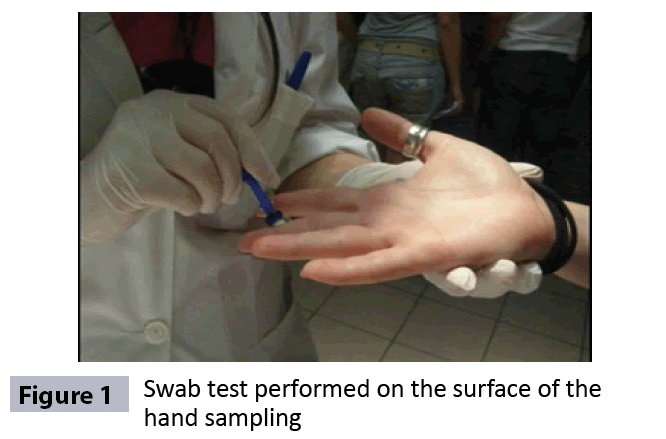
Figure 1: Swab test performed on the surface of the hand sampling
Five hundred students of the TEI of Athens and of Harokopio University participated voluntarily in the sampling of this research. The number of selected volunteers was equally distributed among the two institutes. For the process of sampling a stand with informative posters was installed together with a desk for filling the questionnaires and performing the swab tests on the hands. This installation was placed in a central location of each education institute, in particular: at TEIA in the central corridor of the building and at HUA in the lobby of the central building. Each volunteer student that participated had to fill in an anonymous questionnaire about his or hers personal practices and knowledge on hand hygiene (Questionnaire 1). Then his or her hand (if still willing) was swabbed to estimate the total messophillic flora (TMF) with the portable luminometer. The sampling process was carried for five hours during five week days in each educational institute. Each day swab samples and questionnaires of 50 volunteers were collected. The questionnaire used is presented in Questionnaire 2.
Several hand contact surfaces were also swabbed within the establishments of the two educational institutions. In particular swab tests were performed to the following: handrails in stairs, door handles of auditoria, student desks in the auditoria, door handles of toilets, water taps in toilets, door handles of a laboratory, working benches in a laboratory, central bulletin boards, benches and tables in the corridors. In all cases three different samples were collected.
All questionnaires collected were labelled with the date of sampling and a serial number. The data of the questionnaires was registered in Microsoft Office Excel 2003 worksheets (Microsoft Corporation, Sept. 2003) in alphanumeric and numeric format. Descriptive and comparative analysis was performed with PASW 18.0 (SPSS Inc. 2009).
Results
The mean age of the students that participated in our study was about 22 years (Figure 2). In regard to the sex of the participants, the largest rate corresponds (73.6%) to girls, while the percentage of boys is much lower, corresponding to 26.4%. For the data of this statistical analysis, before we can formulate a conclusion, such as girls are more interested than boys in the hands hygiene subject; it is important to take into consideration that the majority of the students in Harokopio University, in the Department of Home Economics and Ecology, are girls. Thus it is to be expected that the larger percentage of the participants in this study, are girls. This statistical analysis shows the year of study of the participants in the research;, which as shown by the analysis of question 1 the mean is 22 years, it is unsurprising that most students are in the 4th year of their studies. The rates for 1st, 2nd and 3rd year are more or less in the same level, while the number of participants being over their 4th year, is much lower. There is also a very small percentage of the postgraduate participants. According to the above analysis the faculties of Athens TEI and those of Harokopio University, which the participants of this study, attended, the results are shown in Table 1.
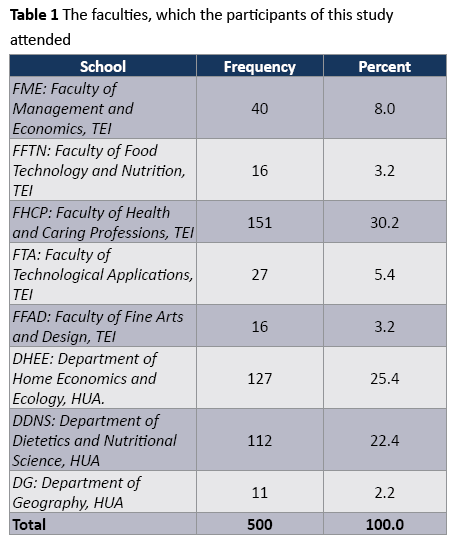
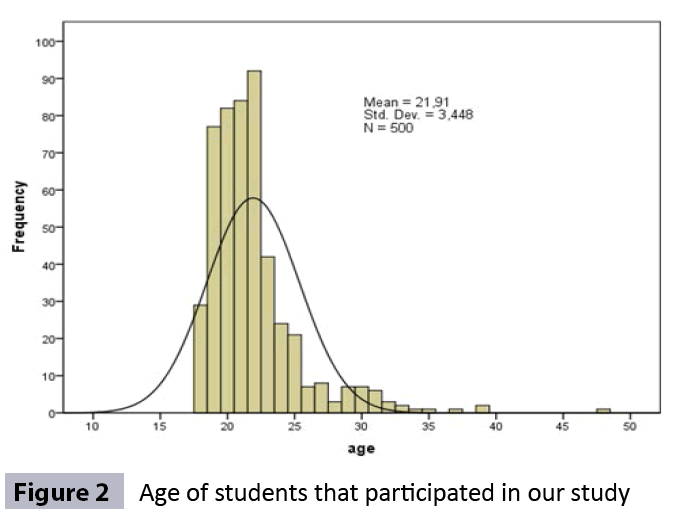
Figure 2: Age of students that participated in our study
We can see that the biggest interest of the Athens TEI students in this study was shown by the ones studying health professions.
That didn’t come as a surprise, since taking care of proper hygiene is a crucial part of their studies. In relation to Harokopio University, the participants from DHEE and DDNS are in the same level, while the ones from the Geography Department are only 2.2% (Table 1).
In the statistical analysis of the 4th question “How many times do you wash your hands in a day?” we can see that the largest percentage of the participants washes their hands more than 12 times a day, while there are a lot that wash their hand from 7 to 9 times (Table 2). The rate of those that wash their hand less than 3 times a day is very small. It is possible that if the participants didn’t have to choose a preset answer, the data would be different. That means that the larger percentage would state that washes their hands much less than 12 times a day, since this calculation is quite subjective and can be easily affected by various choices.
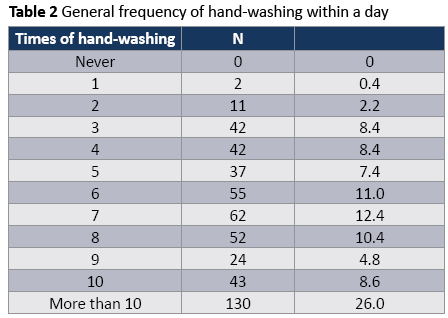
In the 5th question of the questionnaire: “Do you wash your hands after using the toilet?”, as it can be seen from the graph, the larger percentage of the participants always wash their hands after using the toilet (Table 3).
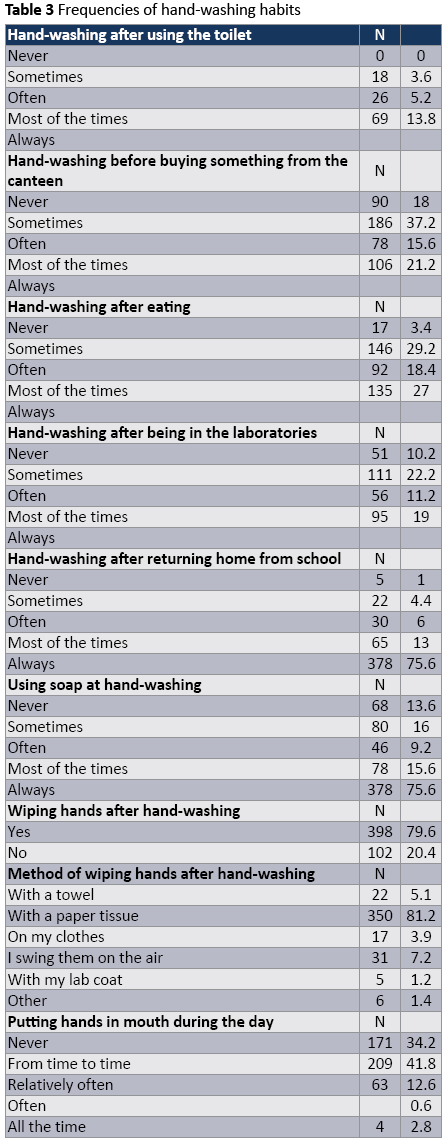
In the 6th question of the questionnaire: “Do you wash your hands, before buying something from the canteen?” according to Table 3 the larger percentage washes their hands before buying something from the canteen.
In the 7th question of the questionnaire: “Do you wash your hands after eating?” as it can be seen by the table there is an almost an equal variance in the responses 2 and 3. That means that the larger part of the participants respond that the wash their hands either often or some times after they’ve eaten (Table 3).
In the 8th question of the questionnaire: “Do you wash your hands after being in the laboratories?” according to this table, the larger percentage of the students that participated in the study, washes their hands after being in the laboratories (Table 3).
In the 9th question of the questionnaire: “Do you wash your hands when you return home?” as we can see in the table, the vast majority of the participants wash their hands when they return home (Table 3).
In the 10th question of the questionnaire: “Do you use soap when you wash your hands, in the University-TEI?” according to this table, the larger percentage of the participants uses soap when they wash their hands in the University-TEI (Table 3).
In the 11th question of the questionnaire: “How often do you put your hands in your mouth, during the day?” according to the following table the larger percentage of the participants puts their hands in their mouth from time to time, while an equally large rate never does that (Table 3).
In the 16th question: “When you are in the premises of your school do you wipe off your hands after washing them?”, we can see that the larger percentage of the participants wipes off their hands after washing then in the premises of their school (Table 3). In the question 17th: “If yes with what do you wipe them off?”, it is demonstrated that 70% of the students that took part in the study, after washing their hands, they wipe them off in a paper tissue or a handkerchief.
In the 18th question of the questionnaire: “Do you wash your hands when you get home from your school?”, it is demonstrated that the 76% of the students washes their hands when they get home from school (Table 3).
In the 12th question of the questionnaire: “Has anyone spoken to you about hands hygiene?”, we can see that the larger percentage of the participants has been informed by parents and teachers (Table 4).
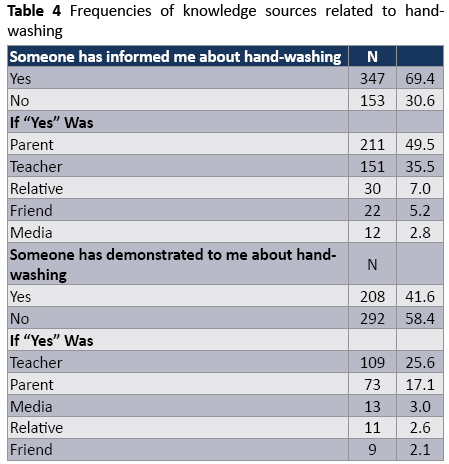
In the question 14th: “Has someone demonstrated how you should wash your hands?”, we can see from the table, that to the larger percentage of the participants there has been a demonstration on how to wash their hands by teachers and parents (Table 4).
In the 21st question of the questionnaire: “When did you last wash your hands?”, we can see from the graph that most of the participants had wash their hands 2 hours ago, some 4 hours ago and a large percentage an hour ago and in the last half hour (Figure 3). On the other hand, the percentage of the participants that hadn’t washed their hands for more than 5 hours was very small.
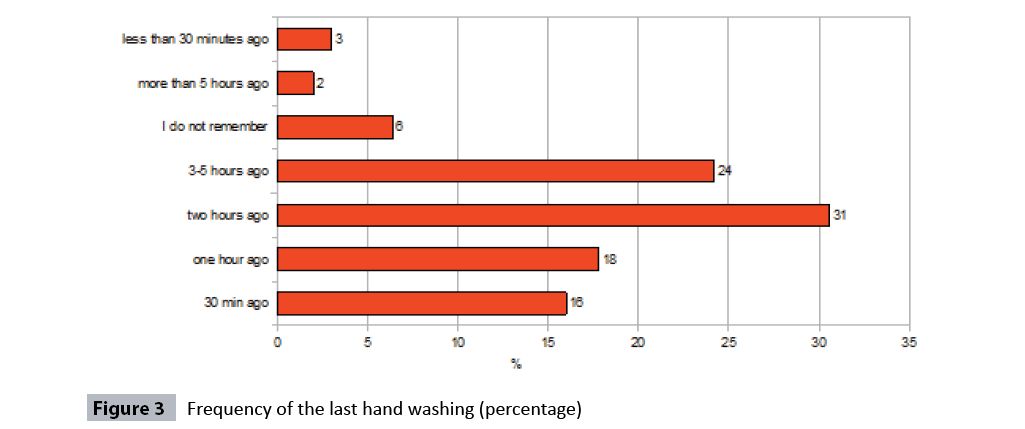
Figure 3: Frequency Figure 3 of the last hand washing (percentage)
In the 22nd question which refers to the results of the RLU measurements, by the statistical analysis of our data, it is demonstrated that the larger percentage of the values ranges roughly between 0 and 3000 RLU (Figure 4). A small percentage ranges from 3200 to 6500 RLU, while the rate above 7000 is very small. A possible explanation for the large percentage of small values can be formulated if we take into consideration the data of the previous question, regarding the time pasted since the participants last washed their hands; which for the most of them was the last two hours.
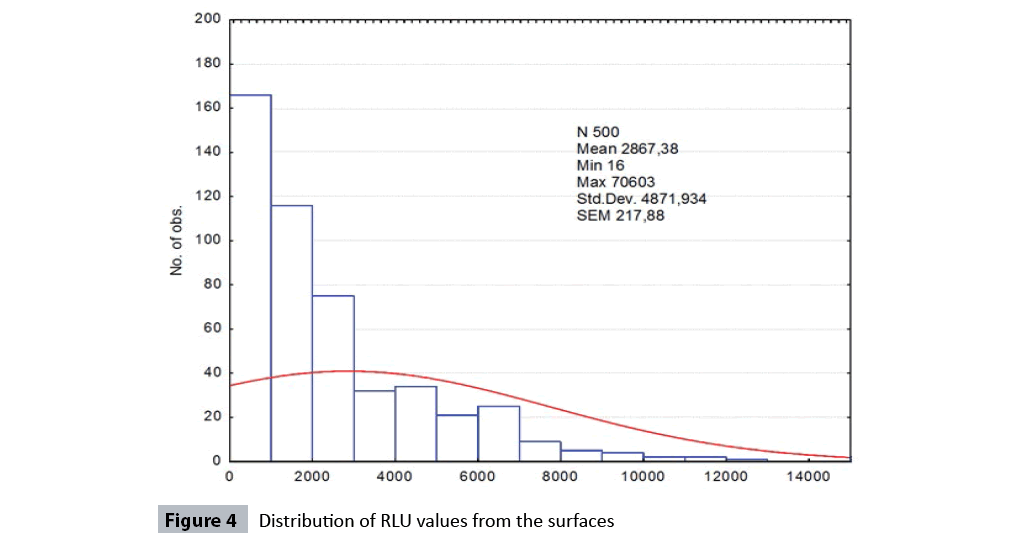
Figure 4: Distribution of RLU values from the surfaces
In the 23st question of the questionnaire: “Since the last time you washed your hands did you do any of the below?”. By the statistical analysis it is demonstrated that 54.6% of the participants in the study, after the last washing of their hands and before the swabbing for the evaluation of TMF, had touched money. Also, a large percentage (28.8%) had participated in a laboratory or had touched food.
Figure 4 demonstrates that the larger percentage of the values ranges from 0 to 5000 RLUs for the surfaces that were swabbed in the Athens TEI and the Harokopio University.
Figure 5 demonstrates that the mean values of the swabbed surfaces in the Athens TEI reaches higher levels than that of the Harokopio University. We should bear in mind though that the number of students in the TEI is much higher than that of the Harokopio University.
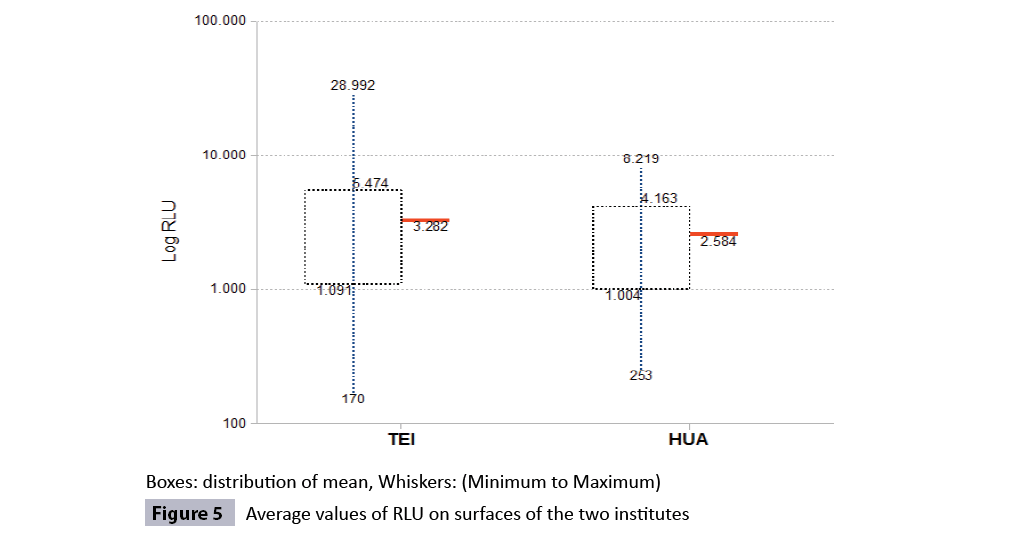
Figure 5: Average values of Figure 5 RLU on surfaces of the two institutes
In Figure 6 the results of the surfaces’ swabbing by surface category are demonstrated. We can see that the highest values are those of handrails and desks, a fact that could be explained if we take into consideration that these surfaces are in contact with much more hands. The same isn’t true for the handles, since most doors are usually open. The values range in the same levels roughly among institutes, with some small differentiations by surface category, although we should expect much higher values for the Athens TEI, if we consider the multiple student population in this educational institution.
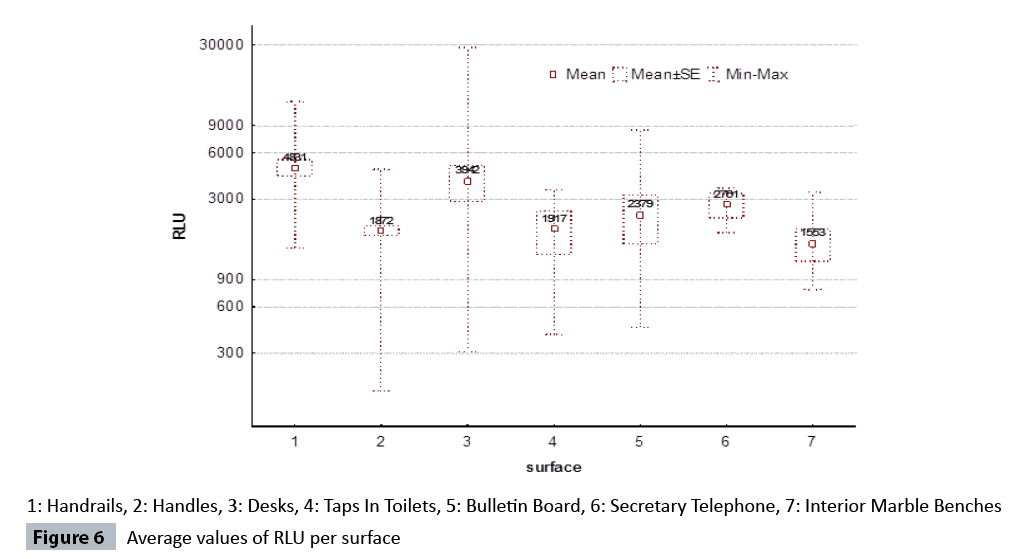
Figure 6: Average values of RLU per surface
Discussion
Hand-washing is one of the most important factors in controlling the spread of micro-organisms and in preventing the development of infections.
Many studies have examined the importance of preventing the transmission of infectious diseases in the school environment, one such studied completed by Cramer et al., indicated this item to be of great concern for the parents of school-aged children [16]. The most common infections transmitted in school environments are respiratory (influenza, pharyngitis etc) and diarrheal illnesses (i.e., Norwalk virus). Most of the infections occur at a constant low level but occasionally outbreaks do occur resulting in increased absenteeism and involvement of public health authorities.
In our study participated 250 students of the Athens TEI and 250 of the Harokopio University and from the descriptive data analysis we see that the mean age of the participants is roughly 22 years and most of them were women (73,6%) while the percentage of men ranges in much lower levels (26,4%). Most of them are fourth year students and some are first, second and third year students, while the students past their fourth year, are much less. However a more careful formulation of the particular question that would ask the semester (and not the year) would help us towards a better comprehension of the numerical field. With regard to the faculties, in which the participants attended, these were in the larger percent students of health professions in the Athens TEI, something that didn’t come as a surprise, since taking care of proper hygiene is a crucial part of their studies. A large part of the participants also came from the departments of Home Economics and Ecology and Dietetics and Nutritional Science from the Harokopio University. A general conclusion that can be drawn, bearing in mind the total responses of the participants, is that they often attend to hands hygiene and have some information on this matter.
Particularly, we see that in question 4, about how many times they wash their hands in a day, most have stated that they do so more than ten times and a large rate more than eight times. However, it is likely that if the question did not involve multiple choice answers, the data might be different. Thus, more precise and objective results could have been obtained in this question if the data were to be totally parametric and not in an order of magnitude as they are. In question 5 about whether they wash their hands after using the toilet, the vast majority of the participants stated that they always do so. In the questions that follow for whether they wash their hands before and after food consumption, most participants stated that in these cases they sometimes do so. Also, most of them always wash their hands after participating in the laboratories and the vast majority of the participants wash their hands when they return home
In question 11 about whether they use soap when they wash their hands in the University and TEI premises, most of them state that they always use soap, while in the next question for how often do they put their hands in their mouth, the larger percentage answers "from time to time" and a large percentage states that they never do. In the questions that follow, the larger percentage of the participants, states that has got some information regarding hands hygiene, and someone has demonstrated to them the proper way for washing. In question 17 most of them state that they wipe their hands in paper when they wash them inside the faculty and in question 18 that they always wash their hands after getting home from the faculty.
In the second part, in the question of 21 (the third of the second part), most of the participants state that they had washed their hands 2 hours ago, some of them 4 hours ago and a large part of them one hour ago and in the last half-hour. However the range of the choices that we had given did not completely cover the participants, since a part of them hadn’t wash their hands for more than 5 hours, while for some less than half an hour had passed since they washed their hands. For this reason and during the statistical analysis we also created two more cases: one for those who stated that they hadn’t wash their hands for more than 5 hours and one for those less than half an hour had passed since they washed their hands.
In question 22, there is the analysis of the results from swabbing of the participants’ hands for the evaluation of TMF. The larger percentage of the values of the values ranges between 0 and 3000 RLU, roughly. A small percentage ranges from 3200 to 6500 RL, while the rate above 7000 is very small. A possible explanation for the large percentage of small values can be formulated if we take into consideration the data of the previous question, regarding the time pasted since the participants last washed their hands; which for the most of them was the last two hours. Based on the experience that we have acquired from this research, we could say that the more time had passed from the last washing of their hands, the bigger the numerical value in RLU.
In the last question, the participants are asked to answer which activities they have been engaging since they last washed their hands and before the swabbing for the evaluation of TMF was conducted. The larger percentage states, that they had touched money and a large percentage that they had participated in a laboratory or had touched food. Again, in this question the range of the choices that we had given did not completely cover the participants, since many of them stated that they used the means of mass transportation or had touched papers, like books or notes. For this reason and during the statistical analysis we also created two more cases: one for those who had used the mass transportation and one for those who had touched papers.
In regard to our results, a systematic review examined the effectiveness of antimicrobial rinse-free hand sanitizers in elementary schools, [17] absenteeism due to communicable illness was the primary outcome variable. Given the potential to reduce student or teacher absenteeism, school operating costs, healthcare costs and parental absenteeism, a well-designed and analysed trial is needed to optimize this hand hygiene technique [17]. The purpose of another study that was to determine the effectiveness of an alcohol gel as an adjunct to hand-washing in reducing absenteeism secondary to infectious illness, showed that alcohol gel as an adjunct to hand-washing can be effective in reducing absenteeism due to infectious illness by 43% [18].
Another study compared the efficacy of an alcohol-based hand sanitizer to standard hand washing in reducing illness and subsequent absenteeism in school-age children concludes that hand sanitizers are an appropriate alternative to hand washing for hand cleansing and may offer additional benefits in the school setting [19].
Finally, a meta-analysis [20] that considered all studies published in English up to the end of 2002, related hand-washing to the risk of infectious intestinal or diarrhoeal diseases in the community. When the results of studies with severe outcomes were combined, hand-washing was found to be associated with a 48% reduction in severe intestinal infections and a 59% reduction in shigelliosis. It was also found that interventions to promote washing hands with soap were associated with a decrease in risk of diarrhoeal disease of 47%. According to the World Health Organisation, [21] hand-washing is very important since 1.4 million people worldwide is affected by healthcare associated infections and the risk in developing countries is 2-20 times higher compared to the developed ones. Hand-washing is a very crucial and important subject and its promotion in schools can be carried out with suitable educational programs including some lessons on microbes and their transmission; by demonstrating the right technique for hand-washing, by posters and with entertaining / artistic approaches. If hand-washing with soap could save over a million lives, if rates of hand-washing are currently very low, and if carefully designed hand-washing promotion programs can be effective and cost-effective, then hand-washing promotion may become an intervention of choice [22].
Conclusions
By the comparative analysis of our data it is shown that the value variance in the bioluminescence that has been measured by the swabbing of the participants hands for the evaluation of the TMF, in relation to age of the participants and in relation to what they had come into contact with since their last hand-washing until the time of the measurement, are statistically significant. On the contrary, sex of the participants, year of studies, faculty and time pasted since their last hand-washing are not statistically significant. We would expect some of those elements to be statistically significant, like for example the faculty in which the participants attend, since the students of the Health Professions Departments are more likely to have a more complete and versatile information for their hands hygiene in relation to students of other departments, the subject of which is less related to heath issues.
Finally, we could say in conclusion that the scope of each faculty, as well as the knowledge that the student’s intake in regard to it influences their daily practice regarding their hands hygiene, something that comes in accordance with our initial hypothesis.
Acknowledgements
This project was funded with the help of Margariti Evi and Salico Marcella, students of Public Health Department, Technological Institute of Athens, and Zidianaki Evaggelia, student of the Science of Dietetics-Nutrition, Harokopio University.
3797
References
- White CG, Shinder FS, Shinder AL, Dyer DL (2001) Reduction of illnessabsenteeism in elementary schools using an alcohol-free instant hand sanitizer. J Sch Nurs 17: 258-265.
- Syed Q, Sopwith W, Regan M, Bellis MA (2003) Behind the mask.Journey through an epidemic: some observations of contrastingpublic health responses to SARS. J Epidemiol Community Health 57: 855-856.
- Centers for disease control and prevention (2004) Questions and answers on SARS.
- WHO (2004) Practical guidelines for infection control in health care facilities
- Guinan M, McGuckin M, Ali Y (2002) The effect of a comprehensive handwashing program on absenteeism in elementary schools. Am JInfect Control 30: 217-220.
- Neuzil KM, Hohlbein C, Zhu Y (2002) Illness among schoolchildren during influenza season: effect on school absenteeism, parental absenteeism from work, and secondary illness in families. ArchPediatr Adolesc Med 156: 986-991
- Centers for Disease Control and Prevention, National Center for Health Statistics (1998) Vital Health and Statistics: Current Estimates from the National Health Interview Survey 1995
- Guinan ME, McGuckin-Guinan M, Sevareid A (1997) Who washes hands after using the bathroom? Am J Infect Control 25: 424-425.
- Pete JM (1986) Handwashing practices among various school age students. Health Educ 17: 37-39.
- Guinan M, McGuckin M, Ali Y (2002) The effect of a comprehensivehandwashing program on absenteeism in elementary schools. Am JInfect Control 30: 217-220.
- Ramseier CA, Leiggener I, Lang NP, Bagramian RA, Inglehart MR (2007) Short-term effects of hygiene education for preschool (kindergarten)
- Lopez-Quintero C, Freeman P, Neumark Y (2009) Hand washingamong school children in Bogotá, Colombia. Am J Public Health 99:94-101.
- Serio M, Pazzagli M (1982) Applications of firefly luciferase. In Luminescent Assays: perspectives in Endocrinology and Clinical Chemistry. Raven Press, New York
- Webster JJ, Chang JC, Manley ER, Spivey HO, Leach FR (1980) Buffer effects on ATP analysis by firefly luciferase. Anal Biochem 106: 7-11.
- Carlo M, Lorenzo L, Marco Z, Anna B, Edoardo C (2002) Assessmentof hand washing practices with chemical and microbiologic methods:Preliminary results from a prospective crossover study. Am J Infect Control 30: 334–340
- Cramer MW, Iverson CJ (1999) Parent expectations of the school health program in Nebraska. J Sch Health 69: 107-112.
- Meadows E, Le Saux N (2004) A systematic review of the effectiveness of antimicrobial rinse-free hand sanitizers for prevention of illness-related absenteeism in elementary school children. BMC Public Health 4: 50.
- Morton JL, Schultz AA (2004) Healthy Hands: Use of alcohol gel asan adjunct to handwashing in elementary school children. J Sch Nurs 20: 161-167.
- Vessey JA, Sherwood JJ, Warner D, Clark D (2007) Comparing handwashing to hand sanitizers in reducing elementary school students' absenteeism. Pediatr Nurs 33: 368-372.
- Luby SP, Agboatwalla M, Painter J, Altaf A, Billhimer WL, et al. (2004)Effect of intensive handwashing promotion on childhood diarrheain high-risk communities in Pakistan: a randomized controlled trial. JAMA 291: 2547-2554.
- Smith RD, Coast J (2002) Antimicrobial resistance: a global response. Bull World Health Organ 80: 126-133.















